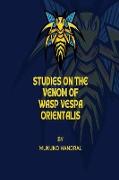- Start
- Studies on the Venom of WASP VESPA Orientalis
Studies on the Venom of WASP VESPA Orientalis
Angebote / Angebote:
Wasp venom is mixture of complex proteins that have several physical and pharmacological properties. The photochemical detoxification of Vespa orientalis venom is expected to generate photooxidized venom sac extract (PVSE). Antigenically active PVSE is obtained by exposing the venom sac extract (VSE) of Vespa orientalis to ultraviolet radiation in the presence of methylene blue. The aim of the present work was to evaluate the effect of PVSE on learning and memory of rats. Detoxification of PVSE was evident since treated mice had longer survival time than the group of mice treated with VSE. Photooxidized VSE of V. orientalis revealed enhancement on learning and memory by shortening the time to reach food (TRF) in T-maze. In a 28-day study with rats, we observed that PVSE significantly decreased transfer latency (TL) in elevated plus maze (EPM), significantly increased step down latency (SDL), diminished step down errors (SDE) and time spent in shock zone (TSS) in step down avoidance test. Thus, we concluded that although there is a possibility of employing PVSE in the treatment of Alzheimer, dementia or neurodegenerative illness as a non-herbal and non-synthetic alternative for patients who do not respond to available therapy, further investigation is still required.
The venoms of arthropods have attracted considerable interest as potential sources of pharmacological substances. Over the past decades, studies have focused on bioactive compounds present in wasp venoms. These compounds include amines, small peptides, and high and low molecular weight proteins such as enzymes, allergens and toxins (1). Vespa orientalis is one of the species of vespine found in most parts of India. The venom of Vespa orientalis (Vo) is a mixture of proteins and chemical constituents with several physical and pharmacological properties produced by the venom gland and injected into prey to paralyze it or employed for defense purposes. The reactions produced by Vespa orientalis stings range from severe pain, local irritation and urticarial papules to serious symptoms. The chemical constituents present in this venom are acetylcholine, serotonin, adrenaline, nor-adrenaline, dopamine, kinins, and high molecular weight compounds such as phospholipase-A2, hyaluronidase, histidine decarboxylase, acid, alkaline, and neutral DNAse, poly and disaccharidase, and several polycationic peptide and protein that act together to produce biological effects (2).
Folgt in ca. 10 Arbeitstagen
